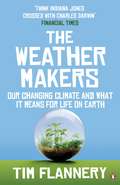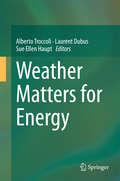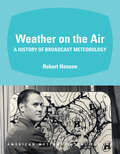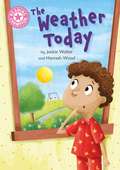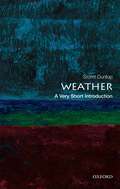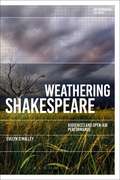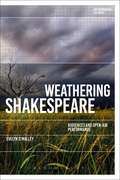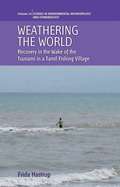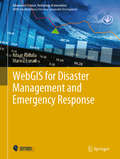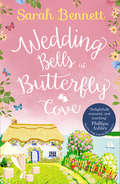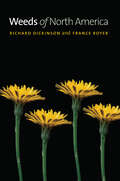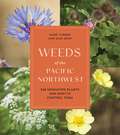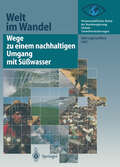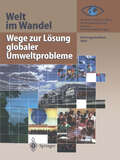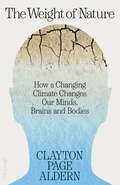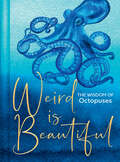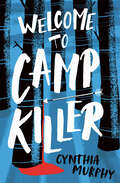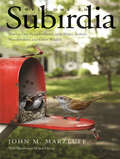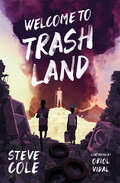- Table View
- List View
The Weather Makers: Our Changing Climate and what it means for Life on Earth
by Tim FlanneryThe Weather Makers tells the dramatic story of the earth's climate, of how it has changed, how we have come to understand it, and of what that means for the future. Tim Flannery's gripping narrative takes the reader on an extraordinary journey into the past and around the globe, bringing us closer to the science than ever before. Along the way he explodes the many illusions that have grown up around this subject.
Weather Matters for Energy
by Alberto Troccoli Laurent Dubus Sue Ellen HauptIt is the purpose of this book to provide the meteorological knowledge and tools to improve the risk management of energy industry decisions, ranging from the long term finance and engineering planning assessments to the short term operational measures for scheduling and maintenance. Most of the chapters in this book are based on presentations given at the inaugural International Conference Energy & Meteorology (ICEM), held in the Gold Coast, Australia, 8-11 November 2011. The main aim of the conference was to strengthen the link between Energy and Meteorology, so as to make meteorological information more relevant to the planning and operations of the energy sector. The ultimate goal would be to make the best use of weather and climate data in order to achieve a more efficient use of energy sources. This book seeks to realise the same objective.
Weather on the Air: A History of Broadcast Meteorology
by Robert HensonFrom low humor to high drama, TV weather reporting has encompassed an enormous range of styles and approaches, triggering chuckles, infuriating the masses, and at times even saving lives. In Weather on the Air, meteorologist and science journalist Robert Henson covers it all—the people, technology, science, and show business that combine to deliver the weather to the public each day. Featuring the long-term drive to professionalize weathercasting; the complex relations between government and private forecasters; and the effects of climate-change science and the Internet on today’s broadcasts. With dozens of photos and anecdotes illuminating the many forces that have shaped weather broadcasts over the years, this engaging study will be an invaluable tool for students of broadcast meteorology and mass communication and an entertaining read for anyone fascinated by the public face of weather.
The Weather Today: Independent Reading Non-Fiction Pink 1a (Reading Champion #515)
by Jackie WalterThis book is part of Reading Champion, a series carefully linked to book bands to encourage independent reading skills, developed with UCL Institute of Education (IOE)The Weather Today is a non-fiction text exploring how different clothes are suitable for different weather. The repeated sentence structure offers readers the opportunity for a very first independent reading experience with the support of the illustrations.Reading Champion offers independent reading books for children to practise and reinforce their developing reading skills.This early non-fiction text is accompanied by engaging artwork and a reading activity. Each book has been carefully graded so that it can be matched to a child's reading ability, encouraging reading for pleasure.
Weather: A Very Short Introduction (Very Short Introductions)
by Storm DunlopFrom deciding the best day for a picnic, to the devastating effects of hurricanes and typhoons, the weather impacts our lives on a daily basis. Although new techniques allow us to forecast the weather with increasing accuracy, most people do not realise the vast global movements and forces which result in their day-to-day weather. In this Very Short Introduction Storm Dunlop explains what weather is and how it differs from climate, discussing what causes weather, and how we measure it. Analysing the basic features and properties of the atmosphere, he shows how these are directly related to the weather experienced on the ground, and to specific weather phenomena and extreme weather events. He describes how the global patterns of temperature and pressure give rise to the overall circulation within the atmosphere, the major wind systems, and the major oceanic currents, and how features such as mountains and the sea affect local weather. He also looks at examples of extreme and dangerous weather, such as of tropical cyclones (otherwise known as hurricanes and typhoons), describing how 'Hurricane Hunters' undertake the dangerous task of flying through them. We measure weather in a number of ways: observations taken on the land and sea; observations within the atmosphere; and measurements from orbiting satellites. Dunlop concludes by looking at how these observations have been used to develop increasingly sophisticated long- and short-range weather forecasting, including ensemble forecasting. ABOUT THE SERIES: The Very Short Introductions series from Oxford University Press contains hundreds of titles in almost every subject area. These pocket-sized books are the perfect way to get ahead in a new subject quickly. Our expert authors combine facts, analysis, perspective, new ideas, and enthusiasm to make interesting and challenging topics highly readable.
Weathering Shakespeare: Audiences and Open-air Performance (Environmental Cultures)
by Evelyn O'MalleyFrom The Pastoral Players' 1884 performance of As You Like It to contemporary site-specific productions activist interventions, there is a rich history of open air performances of Shakespeare's plays beyond their early modern origins. Weathering Shakespeare reveals how new insights from the environmental humanities can transform our understanding of this popular performance practice. Drawing on audience accounts of outdoor productions of those plays most commonly chosen for open air performance – including A Midsummer Night's Dream and The Tempest – the book examines how performers and audiences alike have reacted to unpredictable natural environments.
Weathering Shakespeare: Audiences and Open-air Performance (Environmental Cultures)
by Evelyn O'MalleyFrom The Pastoral Players' 1884 performance of As You Like It to contemporary site-specific productions activist interventions, there is a rich history of open air performances of Shakespeare's plays beyond their early modern origins. Weathering Shakespeare reveals how new insights from the environmental humanities can transform our understanding of this popular performance practice. Drawing on audience accounts of outdoor productions of those plays most commonly chosen for open air performance – including A Midsummer Night's Dream and The Tempest – the book examines how performers and audiences alike have reacted to unpredictable natural environments.
Weathering the World: Recovery in the Wake of the Tsunami in a Tamil Fishing Village (Environmental Anthropology and Ethnobiology #16)
by Frida HastrupThe Asian tsunami in December 2004 severely affected people in coastal regions all around the Indian Ocean. This book provides the first in-depth ethnography of the disaster and its effects on a fishing village in Tamil Nadu, India. The author explores how the villagers have lived with the tsunami in the years succeeding it and actively worked to gradually regain a sense of certainty and confidence in their environment in the face of disempowering disaster. What appears is a remarkable local recovery process in which the survivors have interwoven the tsunami and the everyday in a series of subtle practices and theorisations, resulting in a complex and continuous recreation of village life. By showing the composite nature of the tsunami as an event, the book adds new theoretical insight into the anthropology of natural disaster and recovery.
WebGIS for Disaster Management and Emergency Response (Advances in Science, Technology & Innovation)
by Rifaat Abdalla Marwa EsmailThis book aims to help students, researchers and policy makers understand the latest research and development trends in the application of WebGIS for Disaster Management and Emergency Response. It is designed as a useful tool to better assess the mechanisms for planning, response and mitigation of the impact of disaster scenarios at the local, regional or national levels. It contains details on how to use WebGIS to solve real-world problems associated with Disaster Management Scenarios for the long-term sustainability. The book broadens the reader understanding of the policy and decision-making issues related to Disaster Management response and planning.
A Wedding at the Beach Hut: The escapist and feel-good read of 2020 from the bestselling author of THE BEACH HUT
by Veronica HenryDiscover the gorgeous new summertime must-read from Sunday Times bestseller Veronica Henry - a holiday for the heart and soul!----------------------------------------------------------------------------------------Escape to Everdene Sands, where the sun is shining - but is the tide about to turn?Robyn and Jake are planning their dream wedding at the family beach hut in Devon. A picnic by the turquoise waves, endless sparkling rosé and dancing barefoot on the golden sand . . . But Robyn is more unsettled than excited. She can't stop thinking about the box she was given on her eighteenth birthday, and the secrets it contains. Will opening it reveal the truth about her history - and break the hearts of the people she loves most?As the big day arrives, can everyone let go of the past and step into a bright new future?----------------------------------------------------------------------------------------Your favourite authors love to escape with Veronica Henry's feel-good stories!'As uplifting as summer sunshine' Sarah Morgan'A delicious treat of a book' Milly Johnson'An utter delight' Jill Mansell'Truly blissful escapism' Lucy Diamond'A heartwarming story combined with Veronica's sublime writing' Cathy Bramley----------------------------------------------------------------------------------------And real readers adore Veronica's irresistibly uplifting bestselling books too:'Amazingly heartwarming, full of families, friends and romance''Packed full of wit and charm''I loved all the rich and vibrant characters''Buy it, read it, you'll love it''One of those stories you hope will never end!'
Wedding Bells at Butterfly Cove (Butterfly Cove #2)
by Sarah Bennett‘Delightfully romantic and touching.’ Phillipa Ashley A second chance by the sea?
Weeds of North America
by Richard Dickinson France Royer“What is a weed,” opined Emerson, “but a plant whose virtues have not yet been discovered?” While that may be a worthy notion in theory, these plants of undiscovered virtue cause endless hours of toil for backyard gardeners. Wherever they take root, weeds compete for resources, and most often win. They also wreak havoc on industry—from agriculture to golf courses to civic landscape projects, vast amounts of money are spent to eradicate these virile and versatile invaders. With so much at stake, reliable information on weeds and their characteristics is crucial. Richard Dickinson and France Royer shed light on this complex world with Weeds of North America, the essential reference for all who wish to understand the science of the all-powerful weed. Encyclopedic in scope, the book is the first to cover North American weeds at every stage of growth. The book is organized by plant family, and more than five hundred species are featured. Each receives a two-page spread with images and text identification keys. Species are arranged within family alphabetically by scientific name, and entries include vital information on seed viability and germination requirements. Whether you believe, like Donald Culross Peattie, that “a weed is a plant out of place,” or align with Elizabeth Wheeler Wilcox’s “weeds are but unloved flowers,” Dickinson and Royer provide much-needed background on these intrusive organisms. In the battle with weeds, knowledge truly is power. Weeds of North America is the perfect tool for gardeners, as well as anyone working in the business of weed ecology and control.
Weeds of North America
by Richard Dickinson France Royer“What is a weed,” opined Emerson, “but a plant whose virtues have not yet been discovered?” While that may be a worthy notion in theory, these plants of undiscovered virtue cause endless hours of toil for backyard gardeners. Wherever they take root, weeds compete for resources, and most often win. They also wreak havoc on industry—from agriculture to golf courses to civic landscape projects, vast amounts of money are spent to eradicate these virile and versatile invaders. With so much at stake, reliable information on weeds and their characteristics is crucial. Richard Dickinson and France Royer shed light on this complex world with Weeds of North America, the essential reference for all who wish to understand the science of the all-powerful weed. Encyclopedic in scope, the book is the first to cover North American weeds at every stage of growth. The book is organized by plant family, and more than five hundred species are featured. Each receives a two-page spread with images and text identification keys. Species are arranged within family alphabetically by scientific name, and entries include vital information on seed viability and germination requirements. Whether you believe, like Donald Culross Peattie, that “a weed is a plant out of place,” or align with Elizabeth Wheeler Wilcox’s “weeds are but unloved flowers,” Dickinson and Royer provide much-needed background on these intrusive organisms. In the battle with weeds, knowledge truly is power. Weeds of North America is the perfect tool for gardeners, as well as anyone working in the business of weed ecology and control.
Weeds of North America
by Richard Dickinson France Royer“What is a weed,” opined Emerson, “but a plant whose virtues have not yet been discovered?” While that may be a worthy notion in theory, these plants of undiscovered virtue cause endless hours of toil for backyard gardeners. Wherever they take root, weeds compete for resources, and most often win. They also wreak havoc on industry—from agriculture to golf courses to civic landscape projects, vast amounts of money are spent to eradicate these virile and versatile invaders. With so much at stake, reliable information on weeds and their characteristics is crucial. Richard Dickinson and France Royer shed light on this complex world with Weeds of North America, the essential reference for all who wish to understand the science of the all-powerful weed. Encyclopedic in scope, the book is the first to cover North American weeds at every stage of growth. The book is organized by plant family, and more than five hundred species are featured. Each receives a two-page spread with images and text identification keys. Species are arranged within family alphabetically by scientific name, and entries include vital information on seed viability and germination requirements. Whether you believe, like Donald Culross Peattie, that “a weed is a plant out of place,” or align with Elizabeth Wheeler Wilcox’s “weeds are but unloved flowers,” Dickinson and Royer provide much-needed background on these intrusive organisms. In the battle with weeds, knowledge truly is power. Weeds of North America is the perfect tool for gardeners, as well as anyone working in the business of weed ecology and control.
Weeds of North America
by Richard Dickinson France Royer“What is a weed,” opined Emerson, “but a plant whose virtues have not yet been discovered?” While that may be a worthy notion in theory, these plants of undiscovered virtue cause endless hours of toil for backyard gardeners. Wherever they take root, weeds compete for resources, and most often win. They also wreak havoc on industry—from agriculture to golf courses to civic landscape projects, vast amounts of money are spent to eradicate these virile and versatile invaders. With so much at stake, reliable information on weeds and their characteristics is crucial. Richard Dickinson and France Royer shed light on this complex world with Weeds of North America, the essential reference for all who wish to understand the science of the all-powerful weed. Encyclopedic in scope, the book is the first to cover North American weeds at every stage of growth. The book is organized by plant family, and more than five hundred species are featured. Each receives a two-page spread with images and text identification keys. Species are arranged within family alphabetically by scientific name, and entries include vital information on seed viability and germination requirements. Whether you believe, like Donald Culross Peattie, that “a weed is a plant out of place,” or align with Elizabeth Wheeler Wilcox’s “weeds are but unloved flowers,” Dickinson and Royer provide much-needed background on these intrusive organisms. In the battle with weeds, knowledge truly is power. Weeds of North America is the perfect tool for gardeners, as well as anyone working in the business of weed ecology and control.
Weeds of the Pacific Northwest: 368 Unwanted Plants and How to Control Them
by Sami Gray Mark TurnerA comprehensive guide to the most common weeds of the Pacific Northwest, with essential information on their management and eradication Weeds are everywhere. They crowd out valuable agricultural crops, compete with the tomatoes and beans in your vegetable garden, spread rampantly along roadsides, and pop up from the tiniest cracks in sidewalks. In order to manage them, we must first learn how to identify them. Weeds of the Pacific Northwest is a guide to identifying, controlling, and eradicating over 300 species of weeds that gardeners and homeowners are likely to encounter in Northern California, Oregon, Washington, and British Columbia. Though they can all cause trouble, each weed is different. The hundreds of user-friendly photographs and detailed descriptions of each species here ensure that you can spot and treat any weed in your path. As the experts behind this book demonstrate, some plants can be killed by eating them, some by digging, some by smothering, and some only by the judicious application of chemical herbicides—and it is very important for you and your neighbors to know and understand the differences.
Wege zu einem nachhaltigen Umgang mit Süßwasser: Jahresgutachten 1997 (Welt im Wandel #1997)
by Wissenschaftlicher Beirat Wissenschaftlicher Beirat GlobaleUmweltveränderungenDie globale Süßwasserkrise wird sich zukünftig weiter verschärfen. Neueste Analysen des Wissenschaftlichen Beirats der Bundesregierung Globale Umweltveränderungen (WBGU) zeigen nicht nur die heutigen Brennpunkte, sondern auch die zukünftig für Wasserkrisen besonders anfälligen Weltregionen auf. Zusätzlich werden drei eng mit der globalen Süßwasserkrise in Verbindung stehende "Krankheitsbilder der Erde" untersucht. Aus dieser Zusammenschau leiten die Wissenschaftler in ihrem neuesten Jahresbericht Handlungsempfehlungen für die Politik ab.
Wege zur Koordinierung völkerrechtlicher Verträge: Völkervertragsrechtliche und institutionelle Ansätze (Beiträge zum ausländischen öffentlichen Recht und Völkerrecht #175)
by Nele MatzDie Autorin untersucht am Beispiel umweltvölkerrechtlicher Verträge, inwiefern inhaltliche Überschneidungen und Konflikte zwischen Ansätzen, Zielen und konkreten Regelungen der betroffenen Verträge bestehen und welche Konsequenzen dies für ein kohärentes Regelungsgefüge im Völkerrecht hat. Eine detaillierte und umfassende Erörterung völkervertragsrechtlicher Ansätze mit neuen Lösungswegen zur Bewältigung eines Problems, das in seiner Bedeutung nicht auf das Umweltvölkerrecht beschränkt ist.
Wege zur Lösung globaler Umweltprobleme: Jahresgutachten 1995 (Welt im Wandel #1995)
by Wissenschaftlicher Beirat Wissenschaftlicher Beirat GlobaleUmweltveränderungenFührende Wissenschaftler beschreiben in ihrem Jahresgutachten Wege zur Lösung globaler Umweltprobleme. Im Mittelpunkt stehen dabei gesellschaftliche Voraussetzungen und internationale Vereinbarungen zur Erreichung dieses Zieles. Der Bericht ermöglicht allen an der Lösung von Umweltproblemen Interessierten einen fundierten Einblick in die Problematik. Concise text: Führende Wissenschaftler beschreiben in ihrem Jahresgutachten Wege zur Lösung globaler Umweltprobleme. Schwerpunkte sind gesellschaftliche Voraussetzungen und internationale Vereinbarungen zur Erreichung dieses Zieles.
The Weight of Nature: How a Changing Climate Changes Our Minds, Brains and Bodies
by Clayton Aldern'Penetrating, intensely personal, and impossible to put down, this is a book you need to read.' Annie Proulx, winner of the Pulitzer Prize'This book is a triumph.' Bill McKibbenA riveting, revelatory account of how the climate emergency is changing us from the inside outIt is now inarguable that climate change threatens the future of life on Earth. But in The Weight of Nature, award-winning journalist and neuroscientist Clayton Page Aldern shows that the warming climate is not just affecting our planet – it is affecting our brains and bodies too. Drawing on seven years of ground-breaking research, Aldern documents a burgeoning public health crisis that has gone largely unreported. Eco-anxiety, he shows us, is just the tip of the iceberg. The rapidly changing environment is directly intervening in our brain health, behaviour, decision-making and cognition in real time, affecting everything from spikes in aggravated assault to lower levels of productivity and concentration, to the global dementia epidemic. Travelling the world to meet the scientists and doctors unravelling the tangled connections between us and our environment, and reporting the stories of those who are already feeling these shifts most keenly, Aldern shows how climate change isn’t just around us, but within us. Lucid, urgent and at times deeply moving, The Weight of Nature is a revelation, bringing to light the myriad ways in which the natural world tugs and prods at the decisions you make; how it twists and folds your memories and mental states; how this nebulous everywhere we call the environment is changing our very humanity from the inside out.
The Weight Of Water: A Novel (Windsor Selection Ser.)
by Anita ShreveOn Smuttynose Island, off the coast of New Hampshire, more than a century ago, two Norwegian immigrant women were brutally murdered. A third woman survived by hiding in a cave until dawn. In 1995, Jean, a photographer, is sent on an assignment to shoot a photo essay about the legendary crime. Taking her extended family with her, Jean stays in a sailboat anchored off the coast, and finds herself gradually becoming more and more engrossed in the bay's mysterious and gruesome past. Wandering into a library one day, she unearths letters written by Maren, the sole survivor of the murder spree. Jean's fear of losing all that she cares about is reflected in Maren's poignant tale of love and loss, and her obsession with the ancient story drives her to wild impulsive action -- with unrecoverable consequences.
Weird Is Beautiful: The Wisdom Of Octopuses
by Liz MarvinThink like you’ve got nine brains, feel like you’ve got three hearts, and hug as though you have eight arms.
Welcome to Camp Killer
by Cynthia MurphyBestselling YA horror writer Cynthia Murphy makes her Barrington Stoke debut with a spine-chilling thriller about a summer camp gone deathly wrong.
Welcome to Subirdia: Sharing Our Neighborhoods with Wrens, Robins, Woodpeckers, and Other Wildlife
by John M. MarzluffWelcome to Subirdia presents a surprising discovery: the suburbs of many large cities support incredible biological diversity. Populations and communities of a great variety of birds, as well as other creatures, are adapting to the conditions of our increasingly developed world. In this fascinating and optimistic book, John Marzluff reveals how our own actions affect the birds and animals that live in our cities and towns, and he provides ten specific strategies everyone can use to make human environments friendlier for our natural neighbors. Over many years of research and fieldwork, Marzluff and student assistants have closely followed the lives of thousands of tagged birds seeking food, mates, and shelter in cities and surrounding areas. From tiny Pacific wrens to grand pileated woodpeckers, diverse species now compatibly share human surroundings. By practicing careful stewardship with the biological riches in our cities and towns, Marzluff explains, we can foster a new relationship between humans and other living creatures—one that honors and enhances our mutual destiny.
Welcome to Trashland
by Steve ColeTheo works scouring the dump of Agbogbloshie for scraps to sell for cash. But when a stranger asks for help finding treasure, Theo sees a chance to escape this life. A thrilling new environmental adventure from bestselling author Steve Cole.
